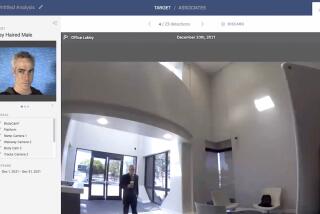Computer: High-Tech Brush for FBI Composite Artists
- Share via
CHICAGO — It might not turn Sgt. Joe Friday into Michelangelo, but a new computer system is enhancing the artistic skills of law enforcement agents whose rough composite sketches of wanted criminals hang on Post Office walls.
“It really is going to revolutionize the way composites are done,” said Myke Taister, a sketch artist at FBI headquarters in Washington.
“It gives us a leverage we’ve never had,” said Special Agent John Larsen of the FBI’s Chicago office, where the new system was launched. “We’re in the 21st Century with it.”
Until now, the bureau’s 25 sketch artists used pencil and paper to turn a witness description into an image of a crime suspect.
Witnesses selected from more than 1,000 facial characteristics pictured in the FBI’s facial identification catalogue, and the artist then went to work to create a hand-drawn composite combining all those features.
But now, with the new FaceKit system, the catalogued facial features are stored in a computer and agents punch in code numbers keyed to each feature.
Instead of waiting for an artist to combine the different features into a face, the computer takes just a few minutes to generate a facial image that can be printed out on paper and transmitted around the country.
“We can have a full composite, from the start of the interview to polishing up, in as fast as 20 minutes,” Larsen said.
That’s about twice as fast as it might take to create a hand-drawn composite.
And the system allows agents like Larsen, who lacks an art background, to create composites.
But he said it does not make the FBI’s trained “visual information specialists” obsolete. They are still needed to put finishing touches on the images and add distinctive features not included in the catalogue, he said.
Taister loves the speed of the new system and said he’s been as busy as ever penciling in details like mustaches and hooded sweat shirts.
“There will always be those special cases . . . that you’ll need the artists for,” he said.
John Holmes, a sketch artist since 1980 and the only one in the Chicago Police Department, can point to other circumstances in which a human brain is needed in the process, like the 1981 case in which a man alleged that his daughter had been abducted.
Holmes sketched while the father described the alleged abductor as wearing a cap identical to one on Holmes’ desk. And Holmes grew suspicious when he realized that the finished drawing looked strangely like himself.
The man eventually admitted the abduction was a hoax and that he had strangled the girl, Holmes recalled.
“The machine can carry you so far, but there’s some details that will never be in the system simply because there’s so many variations in humans,” Holmes said.
The FBI developed the computer system with the QMA division of Infotec Development Inc., a McLean, Va.-based software manufacturer, and launched it in Chicago last year.
It has been used in about 28 bank robberies and kidnapings, and has helped agents make several arrests, Larsen said.
More to Read
Sign up for Essential California
The most important California stories and recommendations in your inbox every morning.
You may occasionally receive promotional content from the Los Angeles Times.













